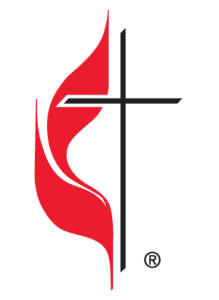History of the Church
SCHUYLERVILLE UNITED METHODIST CHURCH
The History Overview
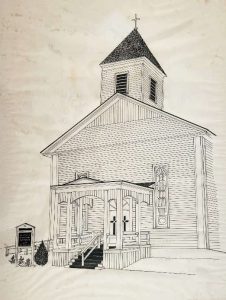
The following information is provided from “A History of the Schuylerville, New York United Methodist Church, 1820-1984,” a 136 pages booklet researched and written by Schuylerville United Methodist Church members, Barbara P. Aldrich, and Maxine E. Larmon.
Early beginnings – Methodist “Societies”
The first Methodist religious society in Schuylerville was organized about 1820. However, preachers were in the area even before that date. The Rev. Peter Campbell was a circuit riding preacher whose circuit included the Schuylerville area.
The “Circuit System” and Incorporation of the Methodist Society
Schuylerville at that time probably was a member of the Philadelphia Conference, which was the circuit conference in existence prior to the establishment of the New York Conference. During the formative years of our present church, worship services and meetings were held in homes, schools, barns – any convenient place for a gathering. The incorporation and registration of the “Methodist Episcopal Church at Schuylerville” occurred during February 1827.
The Deed
The original 1827 handwritten deed, which still exists, conveyed the property (on which the church and parsonage now sits) from Phillip and Grace Schuyler (Grandson of General Philip Schuyler) to the Trustees of the Schuylerville Methodist Episcopal Church.
The Church is Built in 1827!
In the beginning of 1827, a subscription paper was passed among the members of the organized church society to solicit pledges of money with which to build a church building. The pledges ranged from a modest fifty cents pledge up to a breath-taking $200 pledge, including building materials – remember, these were 1827 dollars.
The Methodist Episcopal Church of Schuylerville was erected during the summertime of 1827 and dedicated in the Fall, 1827. The initial cost was $1600. The original building structure, completed in 1827, stands today. It is the oldest Methodist Church building in the area. The Sunday school assembly room, classrooms and the bell tower were added later.
The First Sabbath School
In 1827, at the time of the completion of the church, 35 children were enrolled in the Sunday School, to which Philip Schuyler was a listed contributor.
The First Women’s Organization
In 1832 a Missionary Society was organized. Unfortunately, there are no further records of the work of this society.
Schuylerville Becomes a Station
In 1842 Schuylerville became a “station”. By 1853 the membership had increased to 202 and 105 in the Sunday School, both children and adults.
Affiliation with Victory Mills
In 1852, during the pastorate of the Rev. S.P. Williams, a Methodist Episcopal church was erected in Victory Mills. At that time the Victory Manufacturing Company was in full operation. Funds were donated by the company and residents of the community. The edifice cost a small amount over $3000 and was dedicated in 1854. The Schuylerville and Victory Mills Churches were yoked as a “charge” from 1852 – 1869.
Changes in the Schuylerville Church
Papers dated 1864 noted major changes made when the original structure was remodeled for the sum of $3100. The north and south galleries were removed, fifteen feet was added to the front of the building, and a prayer room, a bell tower were added.
The bell is 40 inches in diameter and is about 40 inches in height, with a thickness of approximately six inches at the bottom. Cast in the brass is the name of the foundry, Jones & Co. Troy, N.Y., the date 1864, and “patented in 1848.”
Extensive repairs to the church building were made in 1888, including building an alcove for the pipe organ (see “The Historic Pipe Organ” section) and an addition to the lecture room.
The Parsonage
The parsonage at Schuylerville was erected during the pastorate of the Rev. J.M. Webster (1881 – 1883) according to his son, Dr. William Webster, who in 1920 described the construction of the parsonage during his father’s tenure thus: “The present parsonage was erected, the main or front portion of the old structure being utilized as a kitchen and dining room, the present main part being constructed entirely new.”
The Church at the Close of the 19th Century
By the late 1800’s the pipe organ had been installed, the choir loft altered, and new Sunday school rooms added. Electric lights had been put in and a furnace installed to replace the wood stoves that previously heated the church.
In 1895 during the pastorate of the Rev. F.G. Heaxt, there were reported to be 300 church members, 70 in the Epworth League and 35 in the Junior League. The church evidently had been growing steadily, for the Manual of 1887 stated, “a great resurgence of religious fervor was occurring…the promise of steady growth, no debt, thriving Sunday School, and general feeling of hopefulness prevailed.”
Affiliation with Quaker Springs, “The Church by the Side of the Road”
In 1935, during the pastorate of the Rev. Milton Lavery, the Quaker Springs Methodist Church joined the Schuylerville Church to become the Schuylerville – Quaker Springs Charge. The Quaker Springs church is known as “The Church by the Side of the Road.” Its congregation was meeting as early as 1842 on top of the hill overlooking the spring for which Quaker Springs is named. In 1844, a barn was bought and moved, then converted into a church building on the site where the present church sits. The Schuylerville – Quaker Springs Charge has a special relationship that exists today!
The Twentieth Century Church Building Events:
Sometime around 1903, lead stained-glass windows were installed. Early in the 1900’s, running water was put in the church and parsonage. Also, the present oak pews were acquired. Among the receipts in the historical papers of the church are found many notations of pew rents having been collected, as this was a major source of income in the early days.
During the term of the Rev. E.M. Broeck (1914 – 1917) the present hardwood floor was laid. Two or three years afterward the slate roof was applied, having been financed by the ladies of the church. An October 22, 1925, receipt from the F.W. Beach Furniture Store on Broadway noted a payment received for two pulpit chairs (still in use today).
During the 1940’s, the chancel was altered to resemble paneled screening. This turned out to be unpopular with many of the parishioners, so Mr. Elton Styles, a master carpenter, was hired to build and install in the chancel the (present) light oak partitioning, the lecterns, the Communion railing, and kneeling benches. He also built
the oak baptismal font and gave it in memory of his late wife, Bertha Styles. Later, Howard A. Weed built two oak sliding music racks.
In 1956, a fire in the Schuylerville church was discovered by a neighbor and the Schuyler Hose Company (located next door) quickly responded to distinguish the flames. The fire damage was extensive. The entire roof had to be re-slated. The fire damage belfry was removed and with it the bell that had been placed there in 1864. Later, a new belfry was built, and the bell was returned to its rooftop position. Also, extensive interior repairs and refurbishing were done and on April 29, 1957, an Open House and Rededication Ceremony was held. The Rev. Howard Hills was the pastor throughout that time.
The 1956 fire caused considerable damage to the building but sparing the historic pipe organ to some water damage only. There was a group of parishioners that stood firm to “Restore” the 1756 pipe organ instead of replacing it. Thus, the restoration began, being supported in the beginning with money raised primarily through rummage sales, paper drives, and memorial gifts. Further long-term plans of several stages of restoration by the Andover Organ Company took place over a 25-year period through the major efforts of the Weed family and The Historic Pipe Organ Restoration Committee. It is estimated that nearly $25,000 had been spent on the restoration project. On January 8, 1984, a Service of Rededication was celebrated by an organ recital given by the church organist, Dale Brockway.
Tragedy again threatened the church in 1979 – the aged furnace malfunctioned, and the radiators and water pipes froze and burst, resulting in extensive water damage to the Sunday School rooms, the Service room, kitchen, rest rooms and hallways. Major repairs and refurbishing were carried out, including installing all new electrical wiring, plumbing, new fixtures, walls, and ceilings. A new furnace was purchased and installed.
The 21st Century Life of the Schuylerville United Methodist Church:
“THE WAY” Community Mission – THE WAY is a gently used clothing store and was established in 2012 by the Schuylerville United Methodist Church and continues to serve the greater Schuylerville communities. The Way store is located on Ferry St., Schuylerville, NY and is 100% serviced by volunteers. We compassionately work all together to make “The Way” the “hands and feet” of Christ in our communities.
Bicentennial Celebration of the Schuylerville United Methodist Church – 2027
During 2025 – 2027, please join us in our Schuylerville United Methodist Church Bicentennial celebration events, along with the 250th (1777-2027) Celebration of the “Turning Point of the Revolutionary War” that occurred in the Schuylerville area.
The Historic Pipe Organ of the Schuylerville United Methodist Church 1756 – Currently Played
The Oldest Continuously Played Tracker Organ in the United States
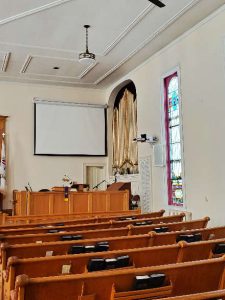
The following information is provided from “A History of the Schuylerville, New York United Methodist Church, 1820-1984,” a 136 pages booklet researched and written by Schuylerville United Methodist Church members, Barbara P. Aldrich, and Maxine E. Larmon.
The Pipe Organ was built in 1756 in London, England, with some parts having been built possibly as early as 1754. This organ, it is believed to be the oldest tracker pipe organ to be continuously played and in use in the United States.
In 1760, the pipe organ was brought to Boston, Massachusetts to be installed in King’s Chapel – the first organ ever to be installed in a Boston church – and immediately the project ran into opposition from the more conservative members of the church. Several months later, it was eventually installed and served the congregation for 80 years, which included the organ music being heard during the Revolutionary period. Later it was purchased by the Congregational Church of Ware, Massachusetts where it was used for about 50 years and then, records show, “…the Congregational Society in Ware voted to sell an organ and appropriate monies for a new organ.”
Installation in the Schuylerville Methodist Episcopal Church – 1888
At a special meeting held July 23, 1888, in the Schuylerville Methodist Episcopal Church, “Dr. W.B. Webster and F.W. Potter were appointed a committee to visit Ware for the purpose of examining and purchasing an organ…”, according to the minutes of the meeting. The organ was duly purchased and brought to Schuylerville and installed in the Methodist Episcopal Church, during the pastorate of the Rev. G.E. Stockwell.
The organ, admired for its rich, beautiful voice, served the congregation well. One of the church’s earliest organists was Mrs. W.B. Webster, in the late 1800’s. Succeeding organists have included Dorothy Webster (daughter of Dr. and Mrs. W.B. Webster), Bess Lansing, Tom Madison, Sally Sidwell, Robert Charbonneau, Susan Armstrong, Dale Brockway, and currently, Pat Poirier.
How is the Sound Produced?
Wind for the wooden pipes was originally provided by a strong boy working a hand pump. An excerpt from the minutes of the Board of Trustee’s meeting dated May 10, 1896, reads “… a collection was taken for the purpose of getting money to pay for tuning organ ($15) and to pay Boy to blow organ while man was tuning ($2.44).”
The boy-powered motor was later electrified. In the minutes of the March 19, 1909, meeting of The Fourth Quarterly Conference is found the following report from the Epworth League: “…Money raised and expended. Organ Motor $20.”
Charles A. Ingraham’s Description of the Organ – 1923
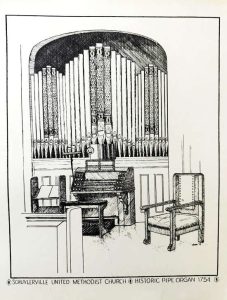
The organ is best described by quoting an article written by Charles A. Ingraham in 1923 entitled An Historic Organ.
“…It is a two-manual organ of unusually fine tone for an instrument of its kind and capacity and is constantly in use. The operating mechanism has been renewed, but the tone-producing parts remain the same which it had when it was the musical wonder of New England.”
“Experts familiar with organ construction say that the materials used in this instrument are of a superior quality and of a kind difficult, if not impossible, to obtain at present day.”
“It has been described thusly: ‘It has six speaking stops in the swell organ and thirteen speaking stops in the great organ; five mechanical stops, pedals one and one- half octave, very few reeds stops, diapasons in both swell and great organ. The diapasons are both opened and stopped, giving the instrument a full, majestic tone which is much admired. The aggregate number of pipes is about 1,100; the large sub- bass are thirty-two feet.”
It is Called a Tracker Organ — What is a Tracker Organ?
According to Dale Brockway (previous organist for over 45 years): “The difference between a Tracker Organ and an electric organ can be likened to the difference between a manual typewriter and an electric typewriter. The pressure exerted is totally responsible for the final impression made when playing a tracker organ; no electric impulse is used. The organist manually pushes down a key which moves a thin strip of Wood called a ‘tracker’ and eventually a pallet opens admitting wind which moves in and causes the sound of the note.”
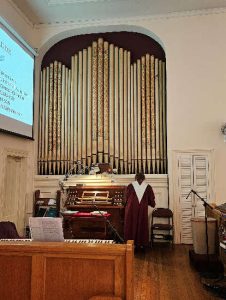
“Although the actual wind chests disintegrated when taken out for repair, the action has been maintained. Our organ is coupled once between the great keyboard and the swell keyboard, which when used, is twice as difficult to sound, as the wind is passing through ALL the pipes whose stops have been opened. Because of the difficult action found in coupling, few organs were manually coupled.”
“The rich sounds made by the wood and metal pipes, along with the tracker action, can not be reproduced by electronic mechanisms.”
Ingraham’s Stirring Account of The Relationship of the Old Pipe Organ with “Saratoga” and Other Events of the American Revolution:
Charles A. Ingraham’s 1923 article An Historic Organ continues: “…The organ has had an historic career: its pipes echoed the thunder of the battle of Bunker Hill, and it heard the tread of the British troops as they evacuated the city of Boston. The British General Gage and his officers undoubtedly listened to this instrument, as did General Washington and his commanders after their occupancy of the town. It should be said too, that General John Burgoyne was in Boston serving with the British Army from May 1775 to the following December, and he probably attended services in King’s Chapel and heard the charming tones which the same organ pours forth today. Moreover, it is an interesting fact that this instrument is now voicing itself on the site of General Burgoyne’s surrendered camp (Old Saratoga), and within a stone’s throw almost of ‘The Field of the Grounded Arms’ where his defeated army laid down their banners and implements of war.”
Celebration of the Historic Pipe Organ during Each Sunday Worship and Upcoming Bicentennial Events
Please join us at the Schuylerville United Methodist Church during Sunday worship to hear this beautiful historic pipe organ “sing praise to the Lord” and at our future upcoming Bicentennial celebration events commemorating our 200 years of Worship in the Schuylerville community!
